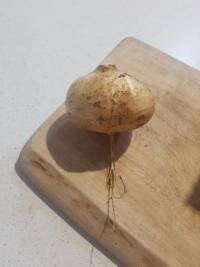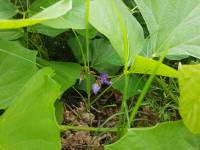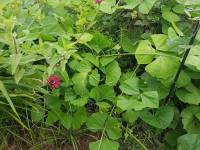Table of Contents
Jicama / Yam Bean
Botanical Information
| Botanical Information | |
|---|---|
| Order | Fabales |
| Family | Fabaceae |
| Genus | Pachyrhizus |
| Common Name | Jicama / Yam Bean |
| Species | P. erosus |
Maturity days
- 150-200
Planting Months
| Planting months | |||||||||||
|---|---|---|---|---|---|---|---|---|---|---|---|
| Jan | Feb | Mar | Apr | May | Jun | Jul | Aug | Sep | Oct | Nov | Dec |
| X | X | X | X | X | X | X | X | X | X | X | X |
Permaculture uses
| Permaculture uses | ||
|---|---|---|
| Usage 1 | Usage 2 | Usage 3 |
| Pioneer | ground cover | animal food, vegetable |
Growing condition comments
| Growing Condition | Comment |
|---|---|
| Drought Tolerant | No |
| Humidity tolerant | Yes |
| Planting area | Garden |
| Sunlight | Full sun |
Photos
Short comments
Keeping the vine trimmed and removal of the flowers / pods to allow the plant to put additional energy into tuber develoment.
Carpenter bees are attracted to the purple flowers.
Only tuber edible (after being peeled), rest of plant is poisonous.
General comments
A tropical legume vine grown for its tuber.
All aspects of the plant above the ground are poisonous and should never be eaten. (Flowers, leaves, stems, and beans etc.) Rotenone is produced by the plant above the surface.
The tubers exterior must be removed prior to consumption.
Flowers are either blue or white with pods similar to lima beans.
Cooking
- The tuber is crisp, white, with a taste similar to apples, or water chestnuts with a slightly sweet flavour. Can be eaten fresh or cooked (after being peeled).
- High in carbohydrates in the form of dietary fibre and composed of 86-90% water. It is a good source of vitamin C.
- Can be added to stir-fries or other dishes as a vegetable. Will take on the taste of the dish.
Jicama should be stored dry, between 12 and 16 degrees. Colder temperatures will damage the tuber. Whole, unpeeled jicama should not be refrigerated. A fresh tuber will keep for about a month or two.


